by Omar Foda
From Founding to Nationalization (1897-1963)

An early advertisement aimed at promoting Crown and Pyramids beer to the Egyptian populous.
From its very beginnings, Stella was a mix of “foreign” ambitions and “native” moneymaking. The beer industry in Egypt combined something new—the large-scale sale of beverages—and something old, given that Egyptians have been producing and selling beverages, often of the alcoholic variety, since Pharaonic times. The capital that drove the industry, the businessmen who profited from it, and the workers who supported the whole enterprise, all existed in the spaces between the so-called “East” and “West.” Likewise, the cultural and social phenomena that drove or repelled the consumption of Stella cannot be easily grouped under headings like “Westernization,” “Modernization,” or even “Islamicization,” but rather represent the fascinating interplay of ideas and concepts from numerous traditions.
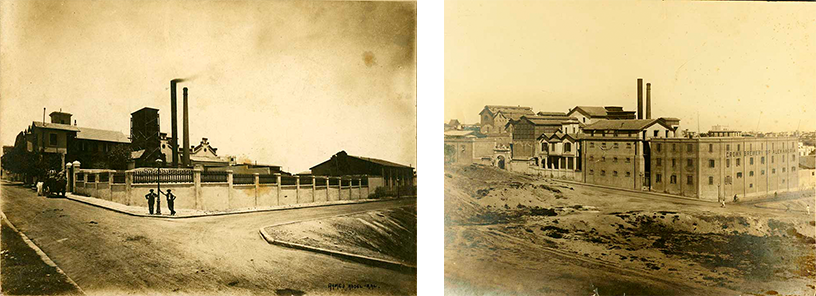
A view of Crown Brewery in the Ibrahimieh district of Alexandria at the beginning of the 1900s (L) and again from a similar angle in the 1920s. Norbert Schiller Collection. Phot. (L) Ahmed Abdel Aal, (R) Dorés

By using the Italian word for star, Stella, they masterfully crafted their product for the Egyptian market. The Italian language, like the culture itself, was perceived as exclusive, as only the truly “educated” Egyptians would know Italian, and yet it was familiar. Due to the long and prominent presence of Italians in Egypt, the Italian language had seeped into Egyptian colloquialisms, especially vis-à-vis luxury products. For example, mūbīlīyya (Arabic colloquial, Furniture) from the Italian mobilia, lūkānda (Arabic colloquial, Hotel) from the Italian lokanda, or even the word for beer itself bīra, from the Italian birra, had entered from Italian,. In addition, the name fit nicely in an Arabic context. The word was easily transliterated into Arabic and contained no difficult sounds for the Arabophone. Even the word written in Arabic was flowing and continuous, containing none of the long vowels that usually break up foreign words written in Arabic. As for the actual star symbol, while not exactly clear in origin, it was most likely derived from the red star of Heineken, which bought into both companies in the 1930s.
The breweries positioned the new beer as an upscale cousin to the blond beers that both breweries were selling under their own names. Stella was also a blond beer, but it had slightly higher alcohol content, 13 percent instead of 12 percent ABV, and a higher price tag. Its target audience was not the elite, who preferred foreign beer brands, but the educated Egyptian middle class. Crown and Pyramid aimed to make Stella the beer of choice for those who saw it as a luxury product and special treat.
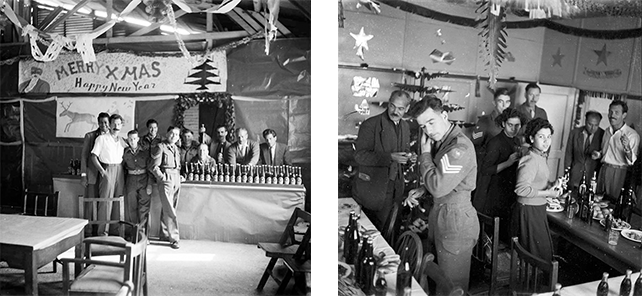
British soldiers hosting a christmas party with plenty of Stella beer. During WWII over a million thirsty Allied soldiers transited through Egypt en route to the various battle fronts. By the end of the war the name Stella was internationally known. Norbert Schiller Collection
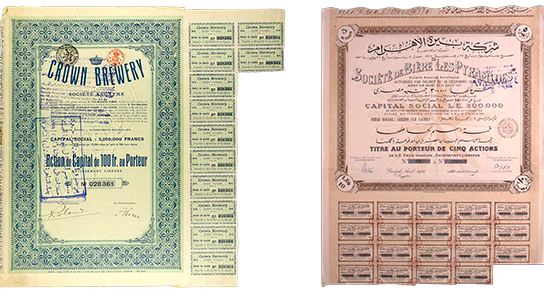
Bonds of Crown and Pyramids Company reissued in the 1950s
The quality and success of Stella caught the eye of the Free Officers’ regime that took control of Egypt in 1952. Nasser in particular, who became president in 1956, was aware of the beer’s appeal, even stopping at Crown and Pyramid’s booth during the Agricultural and Industrial Production Fair on January 3, 1960 to discuss the companies’ success. While the conversation at the fair was a productive one, the attention of President Nasser and his regime was less welcome when it came to matters of nationalization. After the nationalization of the Suez Canal in 1956, every joint-stock company with foreign investors or ties was on high alert for fear of a similar fate. Although they did everything they could to maintain their autonomy, Crown and Pyramid, with their ties to Heineken, were inevitably nationalized in 1963.
Nationalization to the Present
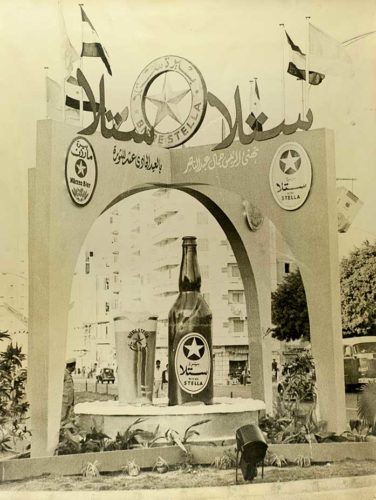
This commemorative Stella decoration reads: “We congratulate President Gamal Abdel Nasser on the occasion of the 11th anniversary of the revolution.” Norbert Schiller Collection
Fortunately for Egyptians, enough experience and manpower remained from the Dutch-owned days that even though Stella became a government-backed monopoly, it produced a beer truly fit for the land of the pharaohs. Much of Stella’s continued quality was attributable to its director from 1963 to 1985, Ismail Omar Foda, a Berkeley trained microbiologist who is also my grandfather. He was a true beer lover and used every resource available to him to make sure Stella lived up to its proud history. That is not to say that this was not without difficulties. For example, import restrictions proved particularly difficult, as they prevented Al-Ahram from importing bottle caps that fit their bottles. Instead the company had to make its own caps, but did not have the proper machinery to get a perfect fit. This would lead to an occasional loose cap and flat beer. It was this issue that led to the creation of the Stella Export brand. Since the brand was aimed only for foreign markets, and could only be bought with foreign currency, it was possible for Al-Ahram to import the caps that best fit those bottles. As a result, Stella’s quality was more assured. The company would work around this and many other problems to provide beer to thirsty Egyptians in the 1960s, 1970s, and 1980s. They were so successful in this period that they had to build a third brewery in Sharkia province to meet growing demand.

Ismail Omar Foda, director of Al Ahram Beverage Company from 1963 to 1985. Antiquated machinery, as seen here inside the brewery in Alexandria, plagued the Company from the time it was nationalized in 1963 until Zayat and his team bought ABC in 1997. Phot. (L) Omar Foda Collection, (R) Norbert Schiller
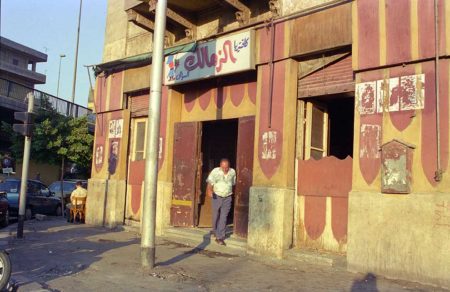
Wooden shutters placed in cafes and bars serving alcohol so that passersby could not look inside became the norm in the 1970s and 80s as the country became religiously more conservative. Phot. Norbert Schiller
Stella found new life in 1997 when the enterprising Egyptian American Ahmed Zayat privatized the company. Zayat and his team were transnational, multi-ethnic, and multi-religious, and he used his foreign business connections to bring in new technology, new distribution methods, and new marketing campaigns. Two of his most significant contributions were the establishment of Drinkies and the priortization of their non-alcoholic offerings, like Birell and Fayrouz. Both initiatives had their roots in the history of the company. Al-Ahram had always had depots where customers could buy beer directly, and had toyed with non-alcoholic products since Dutch ownership. Nevertheless, Zayat’s efforts took each of these initiatives to another level. In sum, privatization was such a success that Heineken, seeing Zayat’s good work, bought back into Al-Ahram Beverage Company in 2002.

Patrons enjoying Stella beer at a local Cairo watering hole in the mid 1990s. A young crowd enjoying Stella at an upscale bar in Cairo after privatization. Pho. Norbert Schiller
However, the success of Al-Ahram could not address the trends that had led to Stella’s marginalization in the first place. Egypt is even more divided today than it has ever been. The momentous events of the Tahrir Uprising and all that have followed have only shown that Egypt is still struggling to define itself. When people cannot agree on the very foundations of their country, a beer has very slim chances for survival.
Stella now sits at the periphery of Egyptian culture and society, a fading memory of Egypt’s proud past. As this exhibit shows, there are still those who speak fondly and highly of Stella. Yet, they are a dying breed and without them the history of Egypt’s beer may also vanish.
Note
All research from “Grand Plans in Glass Bottles: A Social, Economic and Technological History of Beer in Egypt 1880-1970”

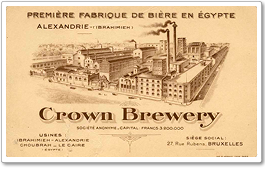


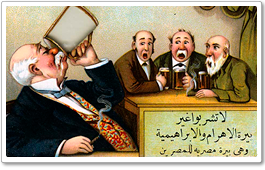

Egypt's Stella Beer: Celebrating 120 Years (1897 - 2017) - Photorientalist
[…] Stella Beer Caught in the Ebb and Flow of Egyptian History […]
I love the historical photos of the old breweries.
I remember nice evenings when we used to drink some Stella in a cafe after movies in Odeon or Nasr CInemas.
I remember also the so called “Bousa” bewery that seemed to me more like Ancient Egyptian product.
News, nuggets and longreads 17 October 2020: memory, colonialism, beer styles – Read Beer
[…] SOURCE: Omar Foda/Photorientalism. […]
“… but it had slightly higher alcohol content, 13 percent instead of 12 percent ABV …”
These numbers seem very big for a mass market beer. Perhaps the numbers are the OG (original gravity) in degrees Plato.
Without knowing the FG (final gravity), it is impossible to calculate the ABV, but perhaps the result would be something like
4.7% ABV versus 4.5% ABV.
I will forward your comment to the author of the story and see what he says.
It s part of Egypt history and ibrahimia history too
Rückblick auf eine schöne Septemberwoche - James & Mac Diving Center
[…] unter Zusammenschluss der beiden ursprünglichen Brauereien. Von dem Zeitpunkt an war Bier in Ägypten gleichbedeutend mit Stella, was bis zum heutigen Tages so geblieben ist. Allerdings merkte damals […]
Does anybody know what was the FIRST beer can in Egypt? And when was it produced?